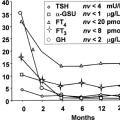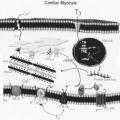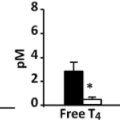Subclinical Hypothyroidism
Douglas S. Ross
The term “subclinical hypothyroidism” was first introduced in the early 1970s coincident with the introduction of serum thyrotropin (TSH) measurements. This term eventually replaced other terms, such as “preclinical myxedema,” “compensated euthyroidism,” “preclinical hypothyroidism,” and “decreased thyroid reserve.” Subclinical hypothyroidism is defined biochemically as a high serum TSH concentration and normal serum free thyroxine (T4) and triiodothyronine (T3) concentrations. Some investigators, especially those studying the neuropsychiatric aspects of hypothyroidism, also consider patients who have normal basal serum TSH concentrations and supranormal serum TSH responses to thyrotropin-releasing hormone (TRH) to have hypothyroidism. Table 47.1 defines the several grades of hypothyroidism that have been suggested (1,2). By definition, patients with subclinical hypothyroidism cannot be identified on the basis of symptoms and signs.
Table 47.1 Grades of Hypothyroidism | ||||||||||||||||||||||||||||||||||||
|---|---|---|---|---|---|---|---|---|---|---|---|---|---|---|---|---|---|---|---|---|---|---|---|---|---|---|---|---|---|---|---|---|---|---|---|---|
| ||||||||||||||||||||||||||||||||||||
Considerably controversy exists regarding the definition of a high serum TSH concentration, the biologic significance of subclinical hypothyroidism, and the indications for treatment. Since there is no consensus, the literature includes divergent opinions; even guidelines and position papers from professional societies disagree.
Serum TSH Concentration
While there is agreement that the definition of subclinical hypothyroidism requires an elevated serum TSH level, there is no agreement on the upper limit of normal for serum TSH. Until recently, most clinical laboratories and most of the studies reviewed in this chapter used values between 4.2 and 5.0 mU/L, or slightly higher, as the upper limit of normal. The 2003 National Academy of Clinical Biochemistry Laboratory Medicine Practice Guidelines suggests that the upper limit of normal would be 2.5 mU/L if euthyroid volunteers had been rigorously screened (3). The American Association of Clinical
Endocrinologists responded to that publication with a press release suggesting that 3.0 mU/L should be the upper limit of normal. A population-based study from Germany, which excluded patients with goiters, nodules, positive TPO antibodies, and a family history of thyroid disease, found the upper limit of normal to be 3.63 mU/L (4).
Endocrinologists responded to that publication with a press release suggesting that 3.0 mU/L should be the upper limit of normal. A population-based study from Germany, which excluded patients with goiters, nodules, positive TPO antibodies, and a family history of thyroid disease, found the upper limit of normal to be 3.63 mU/L (4).
Table 47.2 Common Causes of Subclinical Hypothyroidism | |||||||||||||||||
|---|---|---|---|---|---|---|---|---|---|---|---|---|---|---|---|---|---|
|
Data now support age-based normal ranges for serum TSH, although these are not currently published by commercial laboratories. In the National Health and Nutrition Examination Survey III (NHANES III), TPO antibody negative subjects demonstrated an age-related shift toward higher TSH concentrations: While the 97.5th percentile for TSH was 3.56 mU/L for subjects aged 20 to 29 years, it increased to 4.33 and 5.90 mU/L for those aged 60 to 69 years and 70 to 79 years, respectively, and it was 7.49 mU/L for those over age 80 years (5).
Etiology
The causes of subclinical hypothyroidism are the same as the causes of overt hypothyroidism (see Chapter 34) and are listed in Table 47.2. Most patients have chronic autoimmune thyroiditis, as defined by high serum concentrations of antithyroid peroxidase (anti-TPO) antibodies. In a Michigan outpatient practice, 54% of patients with subclinical hypothyroidism had chronic autoimmune thyroiditis (6), and in a community survey in Whickham, England, 67% of women and 40% of men with high serum TSH concentrations also had high serum antithyroid antibody values (7). Destructive therapy for thyrotoxicosis caused by Graves’ disease is another major cause of subclinical hypothyroidism, accounting for 39% of the cases in the Michigan study (6). Several drugs may cause subclinical (or overt) hypothyroidism, including lithium carbonate, iodine, iodine-containing drugs such as amiodarone, and iodine-containing radiographic contrast agents. Smoking may exacerbate subclinical hypothyroidism and its metabolic consequences (8). External radiation therapy to the neck also may cause subclinical hypothyroidism. The rare patient who is heterozygous for an inactivating mutation in the TSH-receptor gene may have slightly high serum TSH levels consistent with subclinical hypothyroidism (9). A similar phenomenon occurs in patients with pseudohypoparathyroidism Type 1a, who have mutations in the Gsα gene, with defective signal transduction in a variety of endocrine tissues, including the thyroid gland (10).
Inadequate thyroid hormone therapy for overt hypothyroidism results in subclinical hypothyroidism in many patients. In community-based studies from Framingham, Massachusetts and Merthyr Tydfil, Wales, 37% and 17% of older patients taking a thyroid hormone preparation for hypothyroidism had high serum TSH concentrations, respectively (11,12).
Differential Diagnosis
Several causes of high serum TSH concentrations do not properly fit the definition of subclinical hypothyroidism (Table 47.2). One occurs during recovery from nonthyroidal illness, when serum TSH concentrations may be transiently high for a week or occasionally longer. Studies of subclinical hypothyroidism based on serum TSH measurements in hospitalized patients may be invalid because of failure to recognize this cause of high serum TSH values. Apparent subclinical hypothyroidism may be transient following recovery from a destructive thyroiditis. An occasional serum TSH determination may exceed the normal reference range because of a robust pulse of TSH secretion, especially at night, or because of assay variability. Finally, some markedly obese patients may have mildly elevated serum TSH levels that mimic subclinical hypothyroidism, but resolve after bariatric surgery (13)
Therefore, slightly high serum TSH concentrations should be confirmed before the diagnosis of subclinical hypothyroidism is accepted. In one study of over 400,000 individuals, 3% had TSH values over 5.5 mU/L and 62% were normal
on reassessment with no intervention (14). Heterophilic antibodies may cause artifactual elevations in serum TSH assays. Serum TSH concentrations also may be high in patients with adrenal insufficiency and occasionally during treatment with metoclopramide or domperidone. Other rare causes include patients with TSH-secreting pituitary adenomas and resistance to thyroid hormone; patients with the former have thyrotoxicosis, whereas those with the latter are euthyroid or possibly thyrotoxic.
on reassessment with no intervention (14). Heterophilic antibodies may cause artifactual elevations in serum TSH assays. Serum TSH concentrations also may be high in patients with adrenal insufficiency and occasionally during treatment with metoclopramide or domperidone. Other rare causes include patients with TSH-secreting pituitary adenomas and resistance to thyroid hormone; patients with the former have thyrotoxicosis, whereas those with the latter are euthyroid or possibly thyrotoxic.
Epidemiology
Several population-based studies have defined the prevalence of subclinical hypothyroidism. In England (the Whickham Survey), the prevalence of serum TSH concentrations higher than 6 mU/L in the absence of overt hypothyroidism was 7.5% in women and 2.8% in men (7). In women over 75 years of age, the prevalence of subclinical hypothyroidism was 17.4%. In the United States, the National Health and Examination Survey (NHANES III) found a 4.3% prevalence of subclinical hypothyroidism (15); in blacks the prevalence was only 1.6%. In Detroit, the prevalence of high serum TSH concentrations was 8.5% in women and 4.4% in men over age 55 years (16). The higher prevalence of subclinical hypothyroidism in older people was confirmed by data from the Framingham Study, in which the prevalence of minor elevations in serum TSH concentrations in people over 60 years of age was 8.2% in men and 16.9% in women (17), and by a Dutch study in which the prevalence of subclinical hypothyroidism in a group of women (mean age 55 years) was 4%; the rate was 7.3% in the same women 10 years later (18). However, all of these data are confounded by the recent findings that support age-adjusted shifts in the upper limit of normal for serum TSH (5).
Subclinical hypothyroidism is more prevalent in areas of higher, as compared with lower, but not deficient, iodine intake. Among nursing home residents with a mean age of 80 years and similar prevalence of high serum anti-TPO antibody concentrations, the prevalence of subclinical hypothyroidism was 4.2% in relatively iodine-deficient Northern Hungary; 10.4% in Slovakia, where iodinated salt prophylaxis had been mandated for 40 years; and 23.9% in Eastern Hungary, where iodine intake is high (19). More than adequate iodine intake may also increase the risk for subclinical hypothyroidism: In China, the prevalence of subclinical hypothyroidism was 5% in Rongxing and 2% in Chengshan, communities with median urinary iodine excretion of 261 and 146 μg/L, respectively (20).
Natural History
In a follow-up study of persons from the original Whickham Survey (24), women who had high serum TSH and antithyroid antibody concentrations developed overt hypothyroidism at a rate of 4.3% yearly over 20 years, whereas women who had only high serum TSH concentrations or only high antibody concentrations developed overt hypothyroidism at annual rates of 2.6% and 2.1%, respectively. In a Swiss study of women with known thyroid disease followed prospectively for 9 years, overt hypothyroidism developed in 0%, 43%, and 77% of women with serum TSH concentrations of 4 to 6 mU/L, greater than 6 to 12 mU/L, and greater than 12 mU/L, respectively, and was 2.5-fold more likely in those with high serum anti-TPO antibody concentrations (25). In a New Mexico study of asymptomatic ambulatory subjects over 60 years of age with subclinical hypothyroidism, 80% of those whose serum anti-microsomal (TPO) antibody titers were 1:1600 or higher, but none with lower titers, progressed to overt hypothyroidism (26).
The underlying cause of subclinical hypothyroidism also may predict progression to overt hypothyroidism. In one study, 53% of patients with subclinical hypothyroidism followed for 8 years had overt hypothyroidism, and 47% continued to have subclinical hypothyroidism (27). The former group included all patients with autoimmune thyroid disease, prior radioiodine therapy, high-dose external radiotherapy, and long-term lithium therapy, whereas the latter group included patients who had thyroid or neck surgery for indications other than thyrotoxicosis or external neck radiotherapy during childhood.
Clinical and Biologic Importance
The fundamental clinical question regarding patients with subclinical hypothyroidism is whether some or all require treatment with thyroid hormone. While there is agreement regarding the adverse cardiovascular and other effects of subclinical hypothyroidism when serum TSH exceeds 10 mU/L, considerable controversy remains regarding the potential morbidity caused by subclinical hypothyroidism associated with TSH levels less than 10 mU/L. The uncertainty regarding the upper limit of normal for serum TSH concentrations, especially in elderly patients, further confounds the interpretation of studies. Even if adverse cardiovascular events are associated with TSH values under 10 mU/L, there are no outcome data that measure the risks and benefits of treatment with thyroid hormone. Few studies limit their analysis to patients in this important group – subclinical hypothyroidism with TSH less than 10 mU/L – since the inclusion of patients with subclinical hypothyroidism and higher TSH levels increases the chance of positive findings. Furthermore, many studies have insufficient patients or events for reliable conclusions.
On the basis of the natural history of subclinical hypothyroidism alone, one can argue that treatment should be started to prevent the development of overt hypothyroidism, especially in younger patients with positive anti-TPO antibodies. Additionally, goiter, if present, decreases in size in some patients (28). In pregnant women, the presence of both TPO antibodies and TSH levels greater than 2.5 mU/L have been associated with compromised pregnancy outcome in some (29,30) but not all studies (31), and subclinical hypothyroidism during pregnancy has been associated with neuropsychological impairment in the offspring (32); the Endocrine Society Clinical Practice Guidelines recommends treatment of subclinical hypothyroidism in pregnancy (33).
This section summarizes several randomized trials of thyroid hormone therapy and other cross-sectional population-based analyses.
Randomized Trials
In 2007 the Cochrane Collaboration published their assessment of 12 randomized control trials of thyroid hormone treatment of patients with subclinical hypothyroidism, and concluded that treatment did not result in improved survival, reduced cardiovascular mortality, or improved health-related quality of life or symptoms (34). However improvement in lipid profiles and left ventricular function was noted in some studies.
Stay updated, free articles. Join our Telegram channel

Full access? Get Clinical Tree








